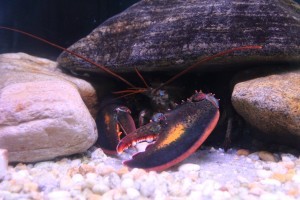Our Crab Villa habitat is home to a fascinating variety of crabs, corals and other invertebrate creatures. Creatures including the great Japanese spider crab (Macrocheria kaempferi) – the largest crab species alive today.
North American Lobsters can be found from North Carolina to Labrador, Canada on the ocean floor, scavenging the bottom for food such as fish, clams, mussels, snails, and crabs. Lobsters have two large claws; one is used for crushing prey while the other is used to hold and rip prey. We have two uniquely colored lobsters, one is blue and the other is orange. The rarity of these colorations is one in a million.In the wild, it is hard for these animals to hide or camouflage in with their surroundings since they are so brightly colored.
Tube anemones are unique animals that form soft tubes made from secreted mucus and fibrous tissue. The tubes can extend well over 3 feet below the sandy ocean floor, and their feeding tentacles stick out from the top, swaying in the current to catch small food particles. Their brightly colored tentacles have fluorescence, absorbing ultraviolet light and reflecting it back as visible light.
Reef lobsters can be found at depths of less than 3 ft 3 in to rocky reefs at depths of 980 ft. They usually only grow to be about 6 inches long and are nocturnal. They hide in little caves or crevices along the reef for most of the day. At night, they will come out of their caves and hunt for a meal. They can strike at prey with their front claws very fast, snatching prey right out of the water column.
There are many different species of crabs that are considered to be Decorator Crabs. These animals will take marine plants or other sedentary animals and fix them to their shells. This provides the crab with great camouflage, blending right into their surroundings so that predators do not recognize them. This method is also a defense mechanism when the crab puts a harmful plant or animal on their back, such as a stinging anemone or noxious algae. What the crab chooses to decorate its shell with is very specialized across the different species. Some species only decorate with sea sponges, others only with algae, and some others use a mix of both.
Sexy Dancer Shrimp are small reef shrimp that grow to be only about half an inch long and are mostly brownish-red with white patches. They will consistently wave their tail upwards in a side-to-side motion, giving them their name. They live among corals and sea anemones in shallow reef communities. These shrimp will eat the mucus produced by anemones or eat the tiny plankton that gets trapped in the mucus of anemones and corals.
Harlequin Shrimp can be found in tropical waters along coral reefs. They grow to be only about 2 inches long and always live in pairs. These shrimp will only eat sea stars, even the venomous crown of thorns sea star. Typically, they will flip a small sea star on its back and start feeding on the tube feet first. Because they go after the tube feet, they are also known to go after sea urchins and eat their tube feet.
Peacock Mantis Shrimp are typically brightly colored with blue, red, and green, often with leopards-like spots along their back. They can grow to be 2 to 7 inches. They burrow along rock structures to create a little cave which they spend most of their time in. They have two front clubbed claws that they use to stun prey. By thrusting a claw out at an extreme speed, it creates a pressure difference in the water so fast that it stuns their prey. Once their prey is immobilized, it will grab it and bring it back to its cave to feed. They also have extremely good eyesight, relying mostly on eyesight for hunting.
Pistol Shrimp are commonly found in coral reefs, submerged seagrass flats, and oyster reefs. They dig burrows and hide in them most of the day. They are considered ambush predators, once a prey item comes across their burrow, they will use their large claw to snap at them, stunning the prey. They usually have a symbiotic relationship with gobies in that the Goby will share the burrow with the shrimp, providing the shrimp with protection.
Spider Crabs are the largest crabs in the world. Including their leg span, they can reach 12 feet in length, with their carapace reaching about 16 inches. They live in cold waters (50F) around Japan in deep waters ranging from 160 feet to over 1000 feet deep. They are scavengers, which means they will walk along the sea floor looking for any food they come across such as dead fish or other crabs.



